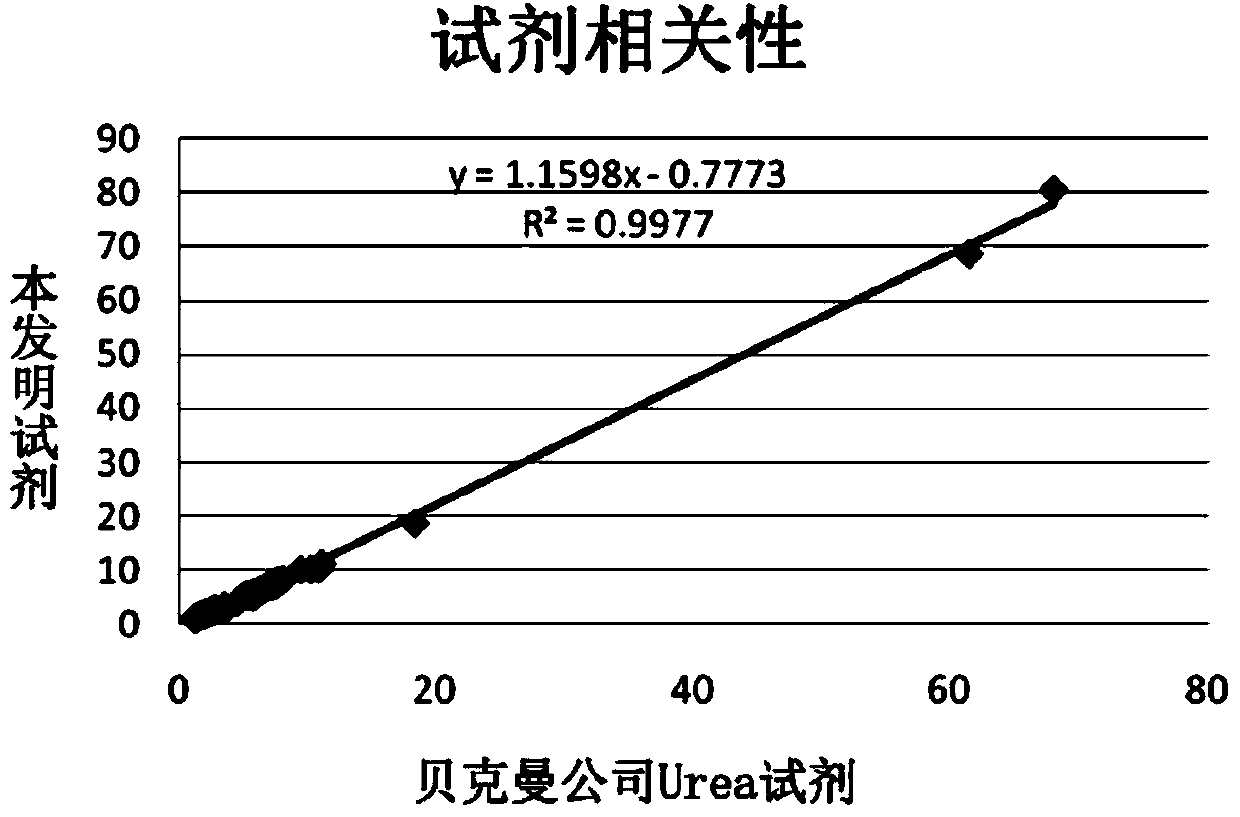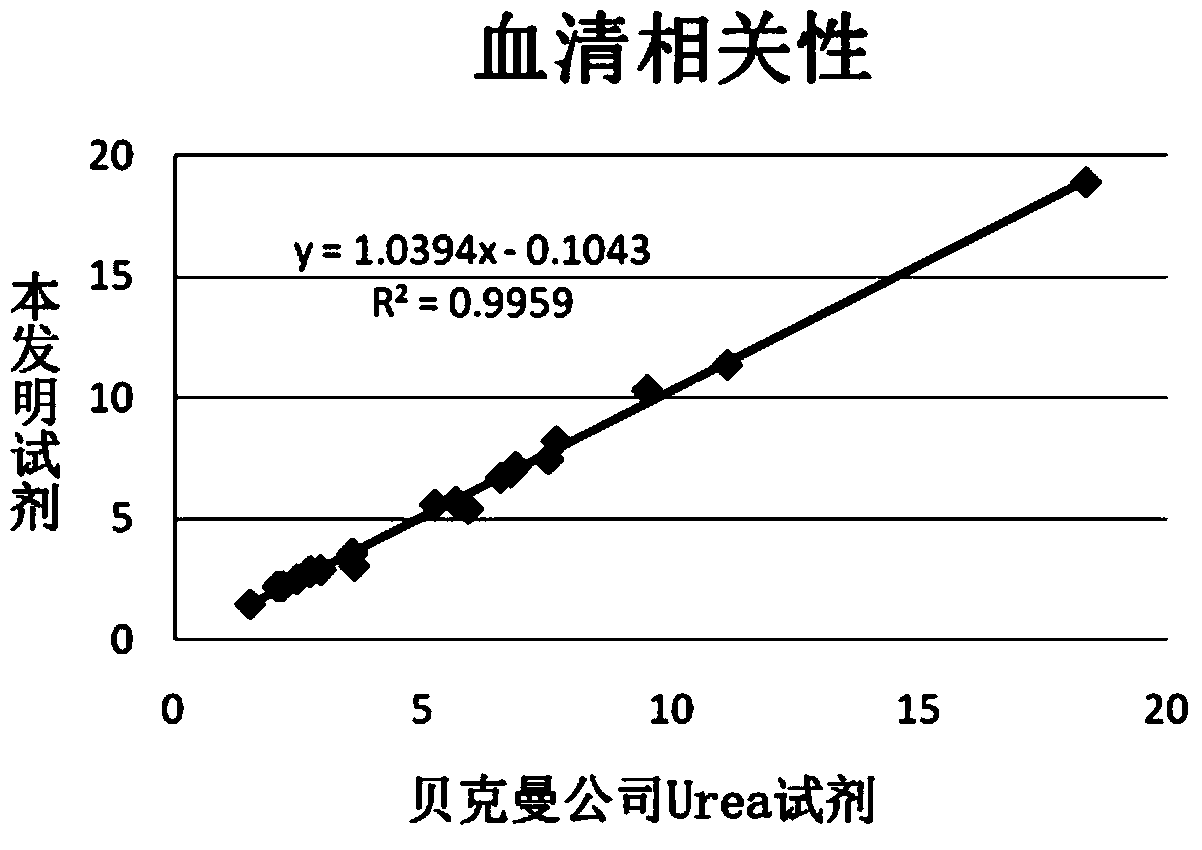Detection kit for measuring content of urea without interference of endogenous ammonia in serum
A technology for detecting kits and urea content, applied in the measurement of color/spectral characteristics, etc., can solve problems such as interference and poor stability of reagents, and achieve the effects of high accuracy, good precision and improved stability
- Summary
- Abstract
- Description
- Claims
- Application Information
AI Technical Summary
Problems solved by technology
Method used
Image
Examples
Embodiment 1
[0035] The composition of the assay kit is as follows:
[0036] 1. Reagent R1 is:
[0037]
[0038] 2. Reagent R2 is:
[0039]
[0040] Components can be added sequentially at room temperature, added simultaneously, or individually packaged and reconstituted immediately prior to testing.
[0041] 3. The reagent detection ratio is 4:1
[0042]The CRE detection kit described in this example is applicable to various types of automatic biochemical analyzers, taking Hitachi 7170 automatic biochemical analyzer as an example, its operation is shown in Table 1. Analysis method: Two-point endpoint method, that is, the amount of reagents R1 and R2 are 240ul and 60ul respectively, and the sample volume is 3.5ul; add 3.5ul sample to 240ul reagent R1 and incubate at 37°C for 5min, add 60ul R2, incubate at 37°C for 1.5min, continuous Monitor the change of absorbance for 180s, and calculate △A / min; the main detection wavelength is 340nm, and the secondary wavelength is 405nm.
[00...
Embodiment 2
[0047] The composition of the assay kit is as follows:
[0048] 1. Reagent R1 is:
[0049]
[0050] 2. Reagent R2 is:
[0051]
[0052] Components can be added sequentially at room temperature, added simultaneously, or individually packaged and reconstituted immediately prior to testing.
[0053] 3. The reagent detection ratio is 4:1
[0054] The CRE detection kit described in this example is applicable to various types of automatic biochemical analyzers, taking Hitachi 7170 automatic biochemical analyzer as an example, its operation is shown in Table 1. Analysis method: Two-point endpoint method, that is, the amount of reagents R1 and R2 are 240ul and 60ul respectively, and the sample volume is 3.5ul; add 3.5ul sample to 240ul reagent R1 and incubate at 37°C for 5min, add 60ul R2, incubate at 37°C for 1.5min, continuous Monitor the change of absorbance for 180s, and calculate △A / min; the main detection wavelength is 340nm, and the secondary wavelength is 405nm.
Embodiment 3
[0056] The composition of the assay kit is as follows:
[0057] 1. Reagent R1 is:
[0058]
[0059] 2. Reagent R2 is:
[0060]
[0061]
[0062] Components can be added sequentially at room temperature, added simultaneously, or individually packaged and reconstituted immediately prior to testing.
[0063] 3. The reagent detection ratio is 4:1
[0064] The CRE detection kit described in this example is applicable to various types of automatic biochemical analyzers, taking Hitachi 7170 automatic biochemical analyzer as an example, its operation is shown in Table 1. Analysis method: Two-point endpoint method, that is, the amount of reagents R1 and R2 are 240ul and 60ul respectively, and the sample volume is 3.5ul; add 3.5ul sample to 240ul reagent R1 and incubate at 37°C for 5min, add 60ul R2, incubate at 37°C for 1.5min, continuous Monitor the change of absorbance for 180s, and calculate △A / min; the main detection wavelength is 340nm, and the secondary wavelength is ...
PUM
| Property | Measurement | Unit |
|---|---|---|
| Dominant wavelength | aaaaa | aaaaa |
Abstract
Description
Claims
Application Information
 Login to View More
Login to View More - R&D Engineer
- R&D Manager
- IP Professional
- Industry Leading Data Capabilities
- Powerful AI technology
- Patent DNA Extraction
Browse by: Latest US Patents, China's latest patents, Technical Efficacy Thesaurus, Application Domain, Technology Topic, Popular Technical Reports.
© 2024 PatSnap. All rights reserved.Legal|Privacy policy|Modern Slavery Act Transparency Statement|Sitemap|About US| Contact US: help@patsnap.com










